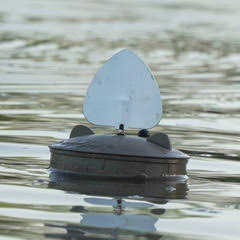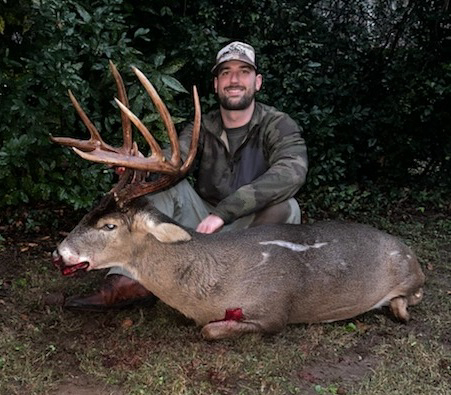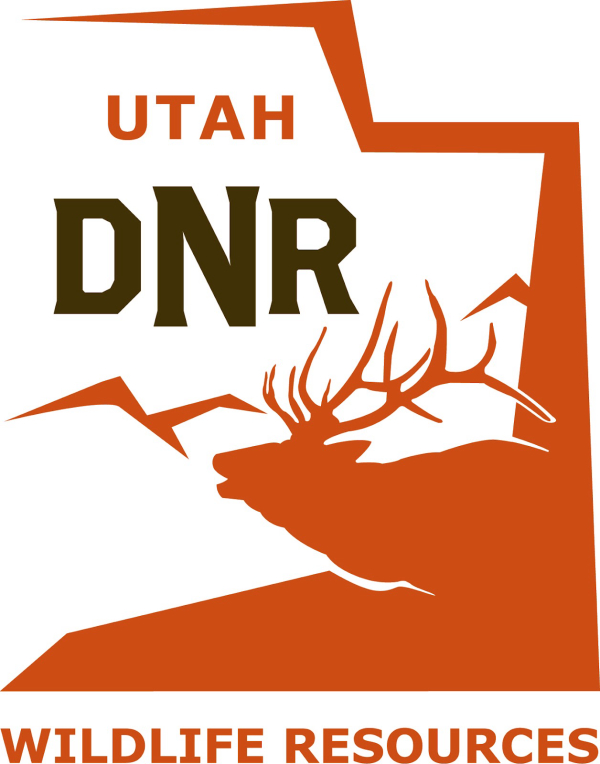Bucks in the City – Hunting Metro Whitetails
 What a terrible afternoon! Two horseback riders had ridden by down the neighbor’s property line and now the other neighbor’s boy was out on his ATV tearing up the ground. He was buzzing by so close I had to turn my face because the breeze was blowing the dust in my eyes. Disappointed, I was about ready to get down out of my treestand when I saw a slight flicker of antler in the sunlight. My binoculars picked out a massive buck bedded down within 100 yards. Now I couldn’t move, nor did I want to!
What a terrible afternoon! Two horseback riders had ridden by down the neighbor’s property line and now the other neighbor’s boy was out on his ATV tearing up the ground. He was buzzing by so close I had to turn my face because the breeze was blowing the dust in my eyes. Disappointed, I was about ready to get down out of my treestand when I saw a slight flicker of antler in the sunlight. My binoculars picked out a massive buck bedded down within 100 yards. Now I couldn’t move, nor did I want to!
The afternoon went on and I cursed the ATV. It was amazing…that buck was bedded within thirty yards of the ATV trail and it never seemed to bother him. Finally the sun dropped behind the trees and the ATV sounds stopped. A couple does popped-up from their beds and ambled by. There were dry leaves but I could hardly hear them, because even though the ATV noises had stopped, rush hour on the highway sounded like flies buzzing in my ears.
My binoculars stayed glued on the buck. At long last he finally rose-up and stretched. He did a good scent-check of the area, waved his nose in the air and started browsing in my direction. To make a long story short, I drove an arrow through both lungs when the buck reached 22 yards and he expired seconds latter about 100 yards away.
Many whitetail hunters talk about heading to “deer camp” or a lease or club somewhere off in the “boonies.” What many of these hunters don’t realize is when driving through suburbia, they are traveling past some of the best deer hunting there is. Whitetails have flourished in many rural areas. In fact, oftentimes the man-made sections and dividers actually make for more attractive “edge habitat” that whitetails favor.
I have grown up on a property that 14 years ago turned into a “century farm.” My family has owned this farm for over 100 years and it’s now of historical significance. Throughout the years I’ve seen this area change from dirt roads and just barely being able to see the neighbor’s yard lights, into now – a suburb of a major city. My worst fear while living here has been that my hunting spots would all be developed and eaten up by the sprawl. That has somewhat come to pass, however, the hunting has actually gotten better, especially for mature bucks.
With the houses closer together, many places that used to be open for gun hunting are now only open for archery – bad for the gun hunter, great for the bowhunter. This now gives bucks a chance to live past their first year and with age comes a chance to sport some decent head-gear. This same phenomenon is happening around big cities all over the country. From Memphis and Montgomery to Minneapolis and Milwaukee, great hunting can be found in the suburbs surrounding these metropolises.
There are both good and bad things about hunting these small tracts created by human inhabitance. The downside is once you gain access these spots can be tricky to hunt. Sure, there’s typically not as much ground to be concerned with and funnels are blatantly obvious with the sections and man-made dividers. On the other hand, these smaller parcels are much more difficult to approach and since the deer live in close proximity to humans day in and day out they learn fast how to avoid making contact with you.
There are more disturbances to contend with in metro areas; such as dogs, bikers, horseback riders, hikers and busy roads just to name a few. However, whitetails become accustomed to these disturbances and really pay them no mind unless they mean immediate danger. I know it’s difficult to tolerate, but whitetails are there all the time and deal with these disturbances even when you’re not there.
Just like when hunting large timber or farmland, one should obtain an aerial photo or satellite image of the property. Search out several different ways to approach each site so you can have alternates depending upon the wind. In smaller tracts it’s especially important to remain undetected. Spooking one doe may set off a chain reaction, bumping all deer from the area.
When hunting these small rural pieces you may be setting up very close to their bedding areas. Not only would I suggest mapping out several stand approach routes, I would go a step further and clean these trails so that you can approach silently. With the sites that you have selected prior to the season it’s a good idea to go out a month before opener and cut silent trails with a pruner or weed-whacker. When the leaves start to fall I may even go back with a rake and remove the debris from the trail. Because of doing this, quite often I will see deer bedded very close after approaching the site and climbing the tree.
Aside from their unbelievable sense of smell, remember deer can see too. I recall a hunting trip to Manitoba where I was hunting a wood lot very near Winnipeg. From this wood lot, which I shared with several other hunters, I could see the tall buildings from downtown and hear the drone of the cars on the highways. I had been in my treestand for a while one afternoon when a fellow hunter, who looked like he had just gotten off of work, pulled off a nearby road and started to get ready. This guy walked a half of a mile across a wide open stubble-field to get to his stand. Every deer in the woodlot saw him approach and bolted. I counted eighteen in all and two would have easily made Pope & Young. I had approached through a creek bed and to my knowledge had gone undetected. I left with the deer.
Scout a lot, but scout smart. Most of my scouting is done at a distance by glassing or with trail cameras. Much can be learned while exerting little or no physical energy.
In my opinion, scouting is the most important aspect leading to a successful hunt. It is especially important for these metro bucks; however, too many hunters “over-scout” a spot because they scout the wrong way. Constant scouring of your area on foot is only going to educate the deer on how to avoid you. Some “boots on the ground” scouting is necessary, but regulate it and scout from the perimeter with optics and let your cameras do the work for you.
Limiting the amount of direct disturbance is especially important if you’re after an older buck. Whitetails are basically “home-bodies,” there’s a reason they live where they do. Yes, I mentioned before there are other types of disturbances that whitetails deal with everyday like dogs and hikers, but I believe they know when they are being hunted. After all, in these metro areas humans are their only predator.
There are some trade-offs. Finding access to property close to metro areas can be difficult. And then, you may have to contend with the traffic, barking dogs, other hunters and hikers. However, if you put forth a little persistence and patience the rewards can be great!
Would you like to learn more about improving your hunting and get discounts on the products you need? Learn from the experts by joining the new Mossy Oak GameKeepers Club at www.gamekeepersclub.com. Or call 844-256-4645.







